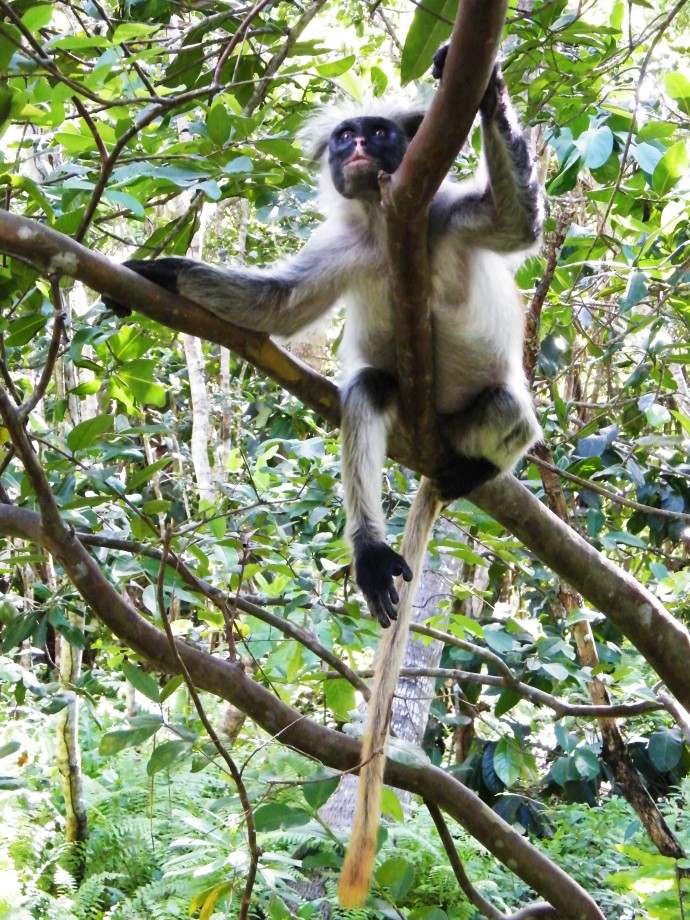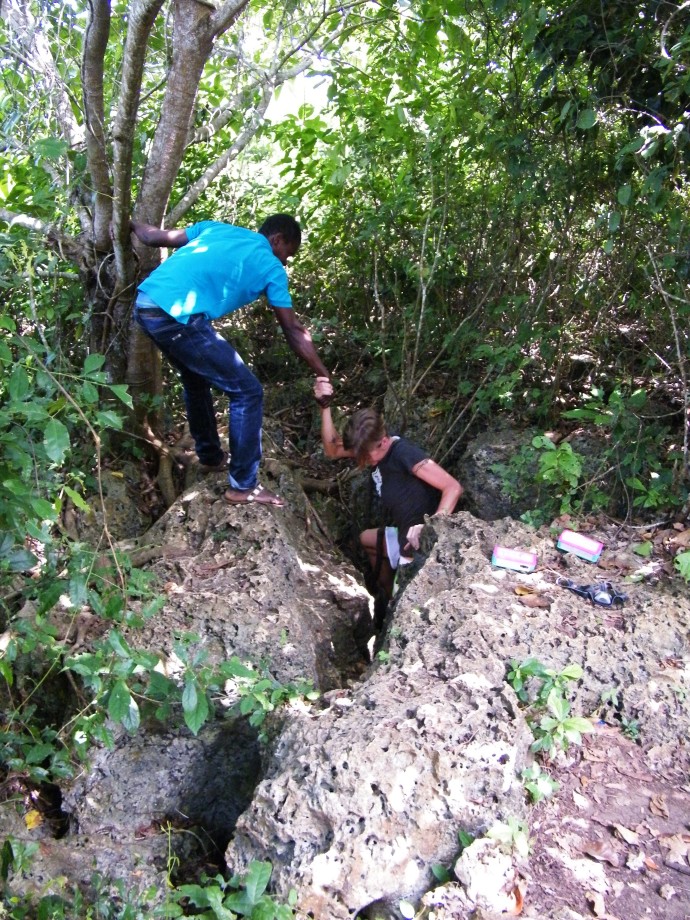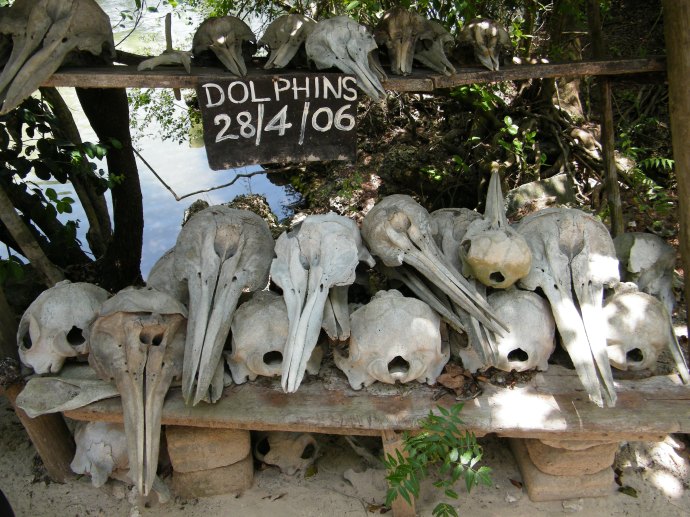I’m not sure if it’s age, over-exposure or, masses of people in general that push Kim and I towards destinations that are essentially “the middle-of-nowhere.” Like actively choosing to sleep in the White Desert of Egypt or pushing on from the bustle of Akureyri, Iceland to the fishing village of Dalvik because the population is only 1,400.
I knew Zanzibar would appeal to Kim for the untainted stretches of beach alone. The island itself is about half the size of Prince Edward Island at 90km long and 30km wide. (In contrast PEI is 224km by 6-64 km in width). But, selling the rest of Zanzibar due to its part-of-Africa status took some fancy footwork.
I insisted that the Spice Island was truly, “soft Africa.” There were no lions or hippos to gobble us up at night. There were no stampeding elephants. The malaria rate was relatively low and the long list of inoculations was just a geographical kink. Beer was readily available despite the Muslim population. Also on the plus side, we’d be ready to travel virtually anywhere after having jabs of meningitis, polio boosters, typhoid , Twinrix (hepatitis) toppers and Dukarol (cholera protectant) cocktails.
It’s usually what you read after you return from a destination when you count your lucky stars. And question your previous rationale. Though we knew about the hijacking of an Ethiopian Airlines plane from Addis Ababa to Rome by the co-pilot just weeks before we departed, we assumed a hijacking couldn’t happen twice, on the same flight path. But, what we didn’t know (and I just discovered in researching this post) was that two homemade bombs blasted the Anglican Cathedral (which we bypassed because it is supposedly always closed—though I did want to see the cross carved out of the fallen mango tree that David Livingstone was buried beneath). However, we were actually at Mercury’s, completely unaware, eating legendary banana and pineapple pizza. The popular seaside bar named after Freddie Mercury of Queen fame, was the other bombing location.
The bombings were on February 25th of this year. Of course, now in the safe cradle of Canada I read further related articles about an attack on two British teens in Stonetown in August, 2013, where acid was thrown into their faces. In the past year attackers have also thrown acid into the faces of both Christian and Muslim leaders. Several churches have been torched in the archipelago with mounting tension. A pastor was shot dead. I guess I missed all those headlines in reading about the darling little elephant shrews and turaco birds.
But, this is the inherent risk of travel. Terrible things happen right here in sleepy, innocent Galt too. If you put too much weight into media headlines and travel advisories, there would be no place left to safely visit. So, back to that sell on “soft Africa.”
Zanzibar offered a competitive blend of fauna, landscape, curries, HEAT and history. Jozani forest had the endemic colobus monkeys, there was a marine turtle sanctuary in the north, slave chambers and a coral cavern and an old prison with a tortoise sanctuary to poke about on Prison Island. I had also scoped out all the places we needed to drink beer: The Rock, Mercury’s and the Africa House Hotel.
Staying on the east coast meant that we were far from the crowds and excess of Kendwa (the “Italian Riviera”). Hurray. But, it also meant that every excursion was a costly one due to transport alone. While a private hire cost upwards of $120 US a day, we still had complete freedom in our ‘schedule’ and no other tourists to contend with. We customized our days.
(*For those who are just tuning in: Kim and I highly allergic to group travel. A cruise (anywhere), Vegas and India are all absolute living nightmares to us. We lean heavily into the far-flung, shoulder season and not-for-everyone type destinations).
Field Trip!
1. The Rock
Visiting the Rock was a no-brainer. Though, in Googling the place you’ll need to be more specific or you’ll be inundated with Dwayne Johnson “The Rock.” Situated on Michamvi Peninsula, Pingwe Beach was a 20-45 minute beachcomb from our lodge, depending on our distraction level with tide pools, twirly shells and urchin sightings.
The small resto is built upon a coral outcrop. At low tide you can walk to the stairs, but at high tide, you’ll need to hop in a boat back to shore or be a stealth swimmer.
The large deck in the back is like pulling up a lounger inside an oven on broil though. Even for sun-mad people like Kim and I, the heat was relentless. It actually led to excessive hydration by means of Safari beers.
We didn’t eat at the Rock as we fell in love with the cheese and tomato-stuffed chapattis at Kichanga Lodge. On the second visit to the Rock we were still stuffed from blue marlin burgers. But, we can attest that for a cold beer, this is the best perch.
It makes me think back to the TVO program we watched last night called Indian Ocean with host Steve Reeves. He took a group of Somali boys living in a refugee camp to the ocean (for many, it was the first time they’d seen the sea). When he asked one of the young men how it felt, to experience the ocean he said, “I think it is good for my eyes. To see this. Beautiful.”
Yes, the Rock and the view is very good for your eyes.
2. Jozani Chawkwa Bay National Forest
The main road actually has monkey crossing signs and speed bumps to calm the traffic. Acquiring an admission receipt to the national park was the equivalent of being granted a passport. At $10 US each, we were more than happy to contribute to such a successful conservation education project. Our guide was a flora and fauna junkie and if we didn’t feel like fainting the entire time from the heat and encouraging him to continue on, we would have probably still been in the forest.
The red colobus monkeys live here—I had no idea we would have such a close encounter with them. Though they are habituated, there is no contact between humans. Of course, we did witness a fine example of two dumb humans thinking they were in a petting zoo, eager to pet the wild monkeys.
The neat part of Jozani is that there’s a little magic in the woods. Though reported extinct, there have been sightings of the legendary Zanzibar leopard. The only proof of its existence is a taxidermy display at the Zanzibar museum and a few skins in the UK and Boston. Locals believe that the leopard is the pet of sorcerers and aren’t exactly as keen to spot one as we were.
Unfortunately, spotting the elephant shrew is probably the equivalent of seeing a moose on a visit to Canada. Same for the night-friendly bushbabies and hyrax. But, the leap-froggin monkey encounter and walk through impossibly tall mahogany and mango trees was enchanting. At times, standing below African pines buzzing with honey bees collecting sap I wondered what continent we were on.
Admission to Jozani also includes a visit to the mangrove forest a humpy-bumpy 7 km away. Yes, we’ve all seen the likes of them in Florida and the Caribbean. In Jozani, the mutant mangroves choke out a dark salt water tributary canal. At high tide the waters are full of red snapper. At low tide you can see the filtering process of the trees in the white residue left on the leaves “sweating out” the salt extracted by the tree roots.
Kim thought we’d entered Sleepy Hollow territory. “Aerial branches” of the mangrove trees grown downwards like stalactites to connect with the ground root system, creating a complex matrix of impenetrable forest. It’s downright spooky.
We followed our guide along a boardwalk above black, soupy muck, passing skeletal remains of dead Indian almond trees. Lizards with skin identical to bark clung frozen to tree trunks. High speed yellow and blue lizards teased us with attempts to get a photo.
Top marks for Jozani.
3. The Mangapwani Slave Chambers and Coral Caverns
It seems that travels with Kim seem to always involve being stuck between a rock and a hard place. Just 20 km north of Zanzibar Town, we first went to the slave chamber (an unsettling square cell cut out of coralline rock). Here, boats carrying human cargo would unload slaves on the beach where they would be transferred to the stuffy, dank chamber for re-sale or work in the plantations.
Eight kilometers away, in the natural coral caverns where slaves were hidden after abolition in 1873, I figured we would get a similar condensed history in the main chamber of the cave and exit. The floor was a jagged, ragged coral that split into two tunnels. Abdul handed me the first flashlight ever invented—a big boxy pink thing with less light than a candle. Kim was golden with her Petzl headlamp at the ready.
Abdul insisted we penetrate the cave depths—just a five to seven minute walk and we could see the freshwater pools and exit through a hole. Or, we could walk over a mile through the opposite tunnel to the beach. No thanks.
We were all in flip flops—Abdul could probably climb Everest in flip flops. Africans do everything in flip flops. But us? I looked at the cave floor and visualized a sprained ankle or a Polysporin-sponsored vacation after our exit. Abdul insisted we would be fine.
I can’t even compare what the terrain was like to walk on. But, then I had a smack of reality remembering the slaves who did this route without complaint or footwear years ago.
I was totally terrified of a wipe-out and scurried behind Kim with my transistor radio-sized flashlight. The cave lacked any remarkable stalactites or geological colouring, but the history made the walls nearly whisper.
The exit didn’t come soon enough for me. Even then, we had to crouch and emerge into a hole that was seven feet from the surface. Now we were rock-climbing in flip flops, hoping for rooty hand-holds and not a handful of one of the fat sausage-sized millipedes we’d seen.
We survived, narrowly. This was also a $10 experience of sheer terror and unexpected adventure.
4. Mnarani Natural Aquarium Marine Turtle Sanctuary, Nungwe
This sanctuary is housed in a natural lagoon in the most northern tip of the island. Since 1993, local fisherman who accidentally net green and hawksbill turtles are offered money to safely bring the turtles to the sanctuary. In Zanzibar, they were prized for their meat). The exchange program has been a positive conservation effort and locals take immense pride in the success of the partnership.
Mnarani (‘the place of the lighthouse’ in Swahili) is very much a homemade zoo. But, they are doing remarkable work in giving hatchlings a boost in survival. Nests on the Nungwe beaches are monitored and hatchlings are brought to holding pens in the lagoon where they are kept for ten months before being released back into the ocean. At 10 inches and 10 months old, their chance to thrive is increased dramatically.
Enthusiastic guides are eager to share their knowledge. You can hand-feed the turtles here and watch an entire school of jackfish skip to the surface upon feeding.
The sanctuary has a big bone collection to boot. In addition to a humpback whale (though space limits displaying all the vertebrae), several coffee-table sized turtle shells, there are shelves of dolphin skulls—remnants of a haunting die-off of over 700 dolphins that washed ashore at Kendwa and Nungwe. The 2006 incident is still unsolved—whether it was naval sonar, seismic activity or a red tide, scientists are still baffled.
5. The Italian Riviera—Kendwa Beach
We wanted to spend some lounge time on the west coast beach that gets so much press. It easily confirmed how happy we were to be at Kichanga Lodge on the east. Monster hotels run along the strip with characteristic thumping music, vendors scurrying about selling sunglasses (Kim did find a flashy pair of “Roy Dans”—Ray Ban knock-offs), snorkelling tours and the like. Make-shift shops are staffed by five or six men desperate to pull you from the beach to see their tiny warehouse of ebony carvings and Masaai bead work.
The beach is of course, beautiful, but it’s the ugly side of tourism. We saw a monkey on a short leash and a bus load handing money to a crew of local kids asking for “dollaros.” The kids here are smart—they’re nearly fluent in Italian.
As per usual, Kim and I made our way to a lonely lagoon, far from the crowds, bobbed in the ocean undisturbed and absorbed the horizon with progressively warmer beers on the beach.
After such idyllic, suspended days on the Michamvi Peninsula, were we ready for the buzz, touts and congestion of Stonetown?
Stay tuned.
















